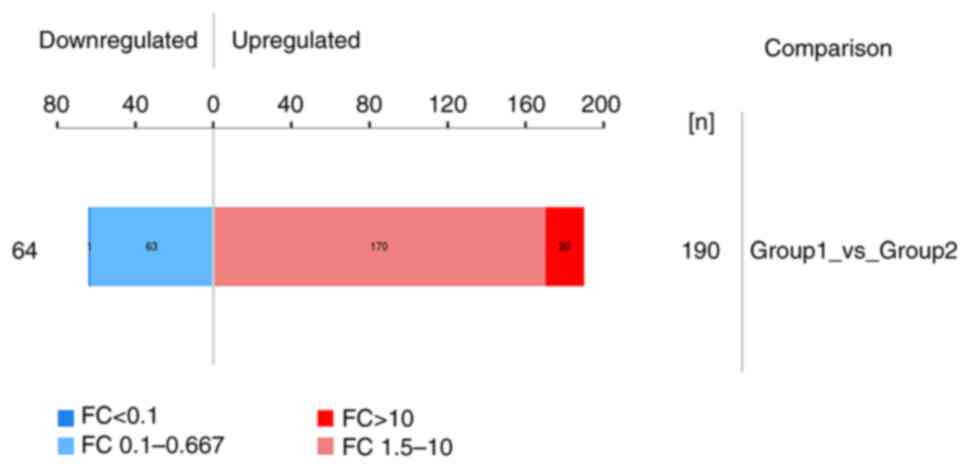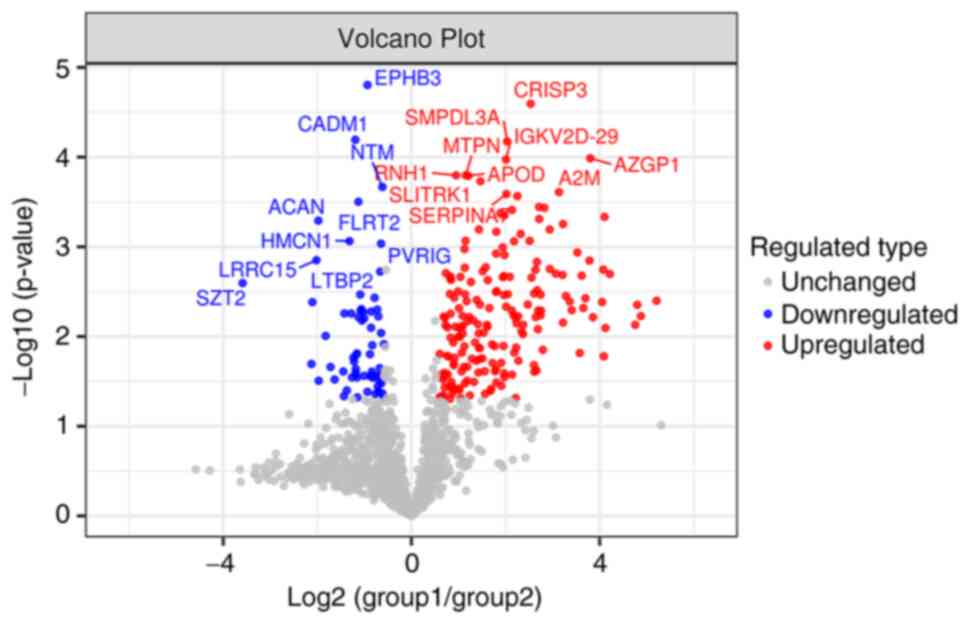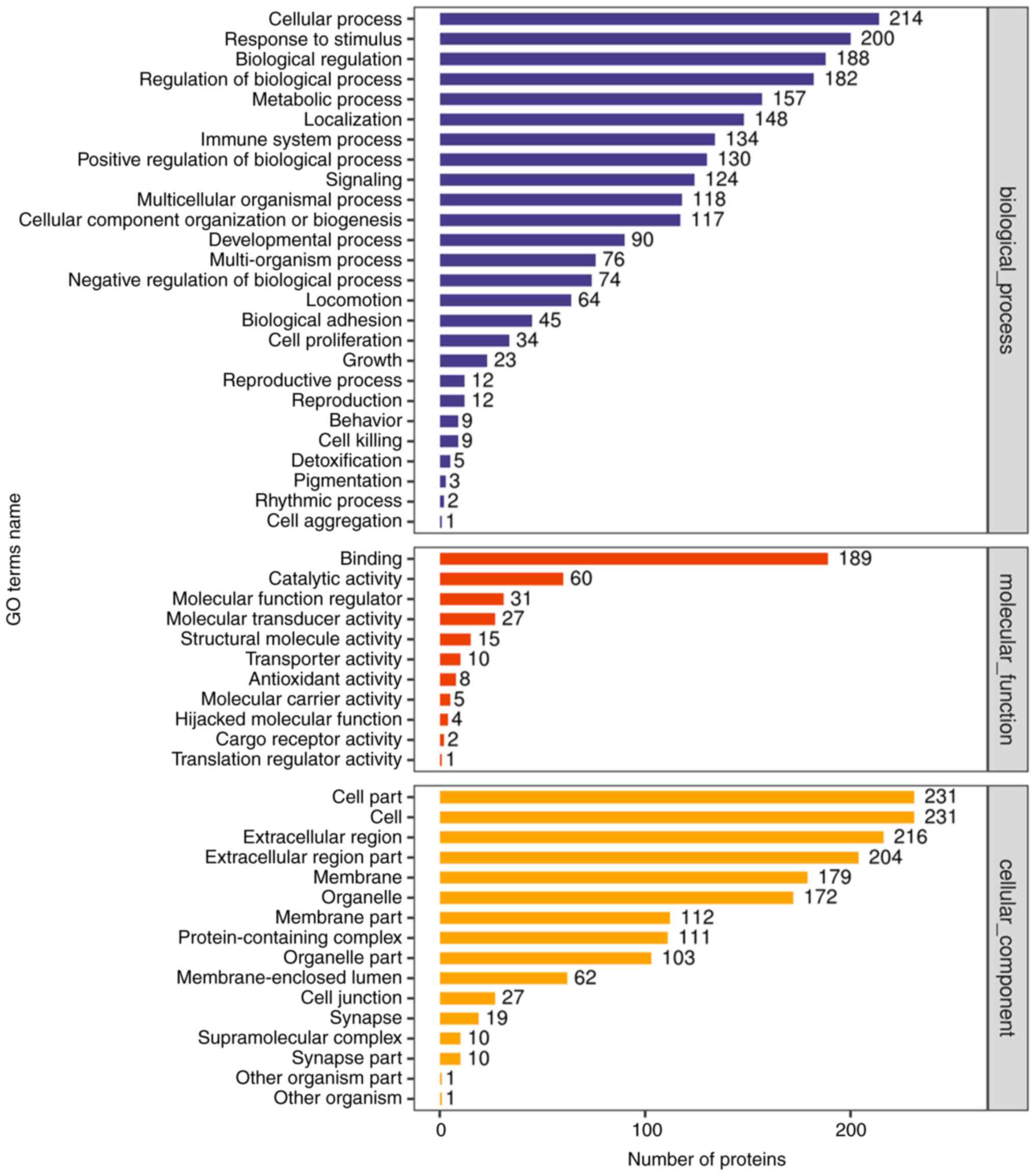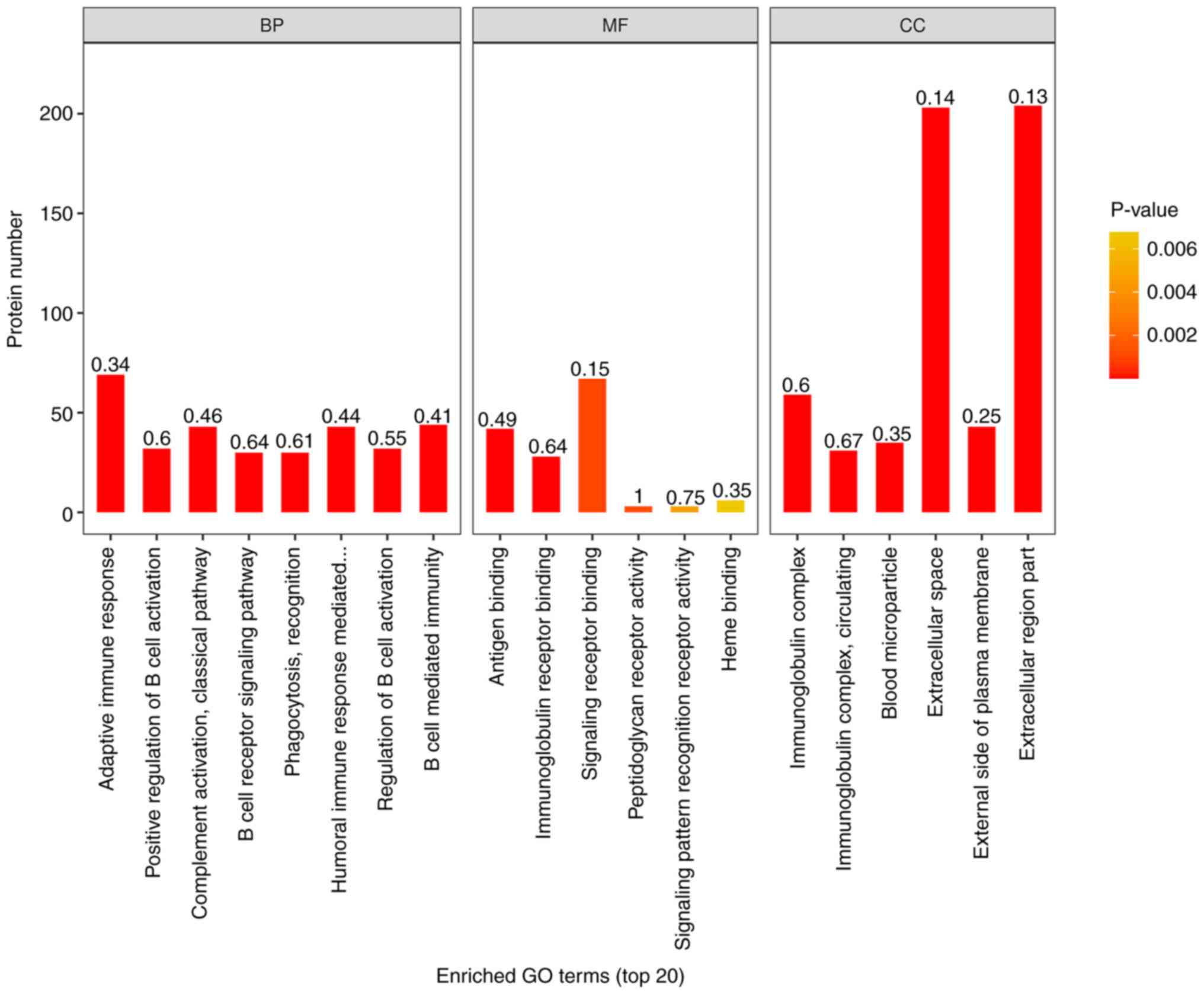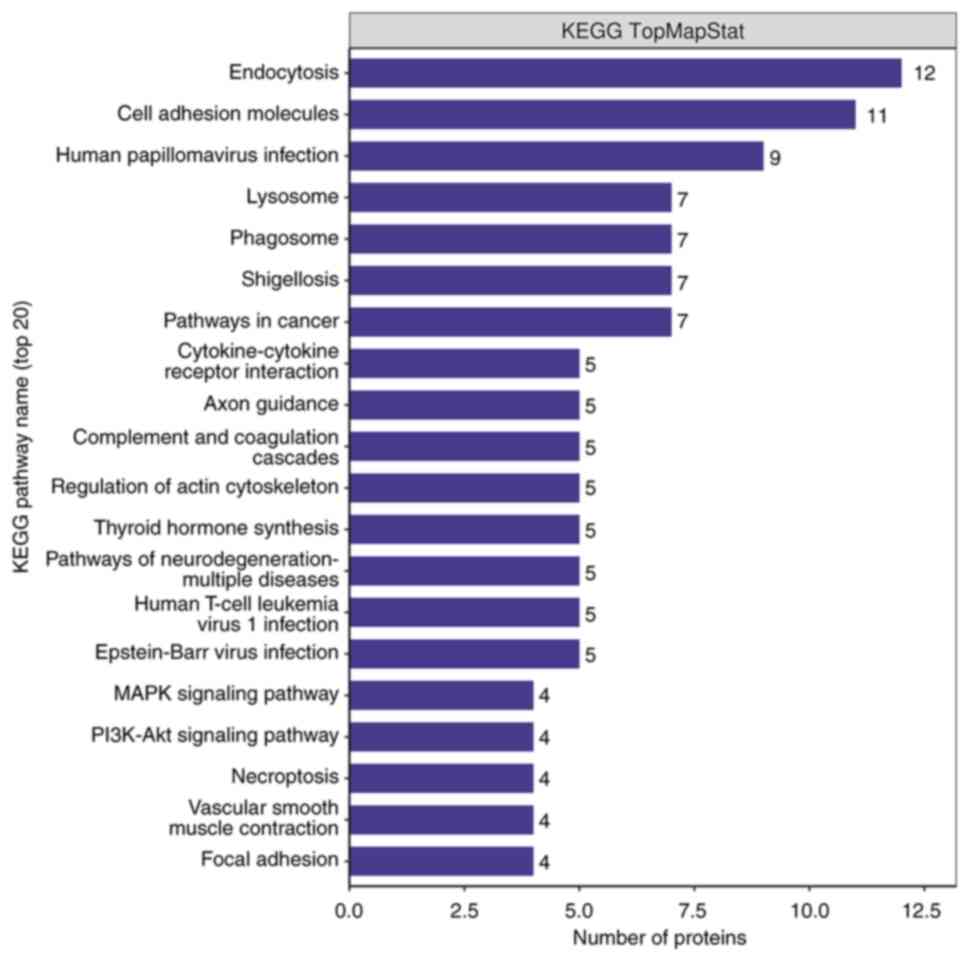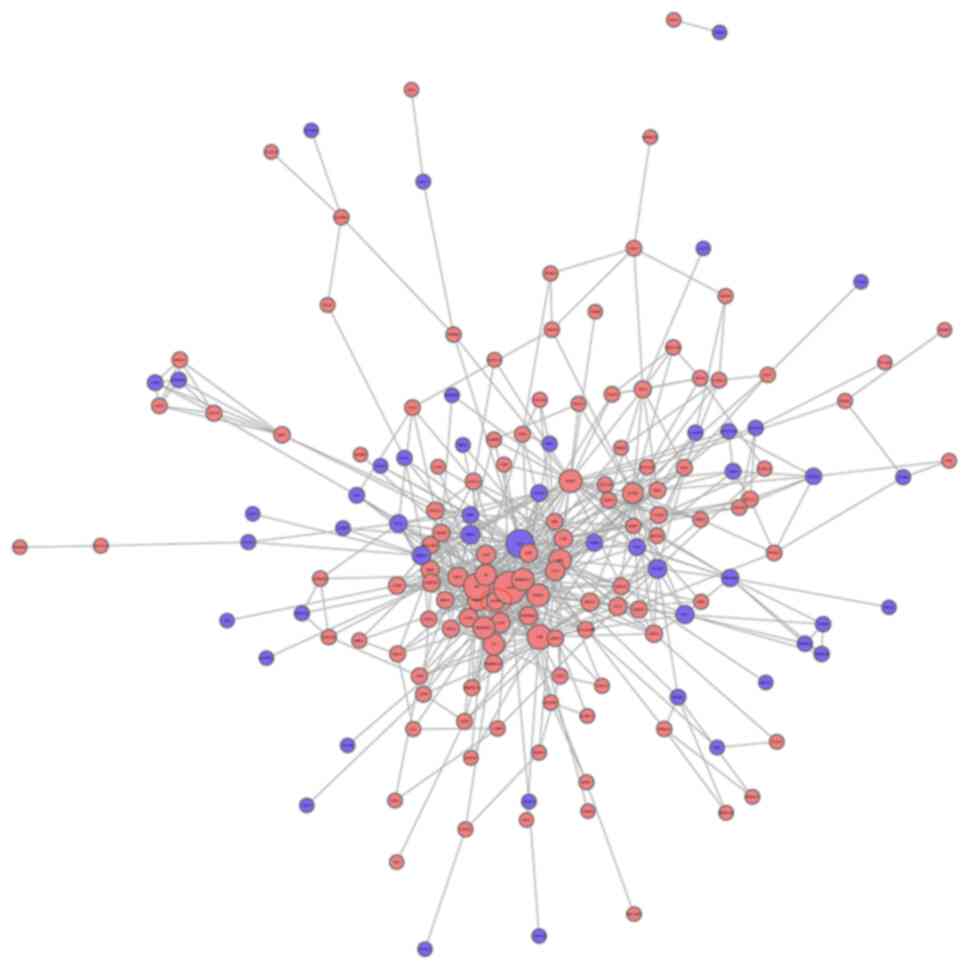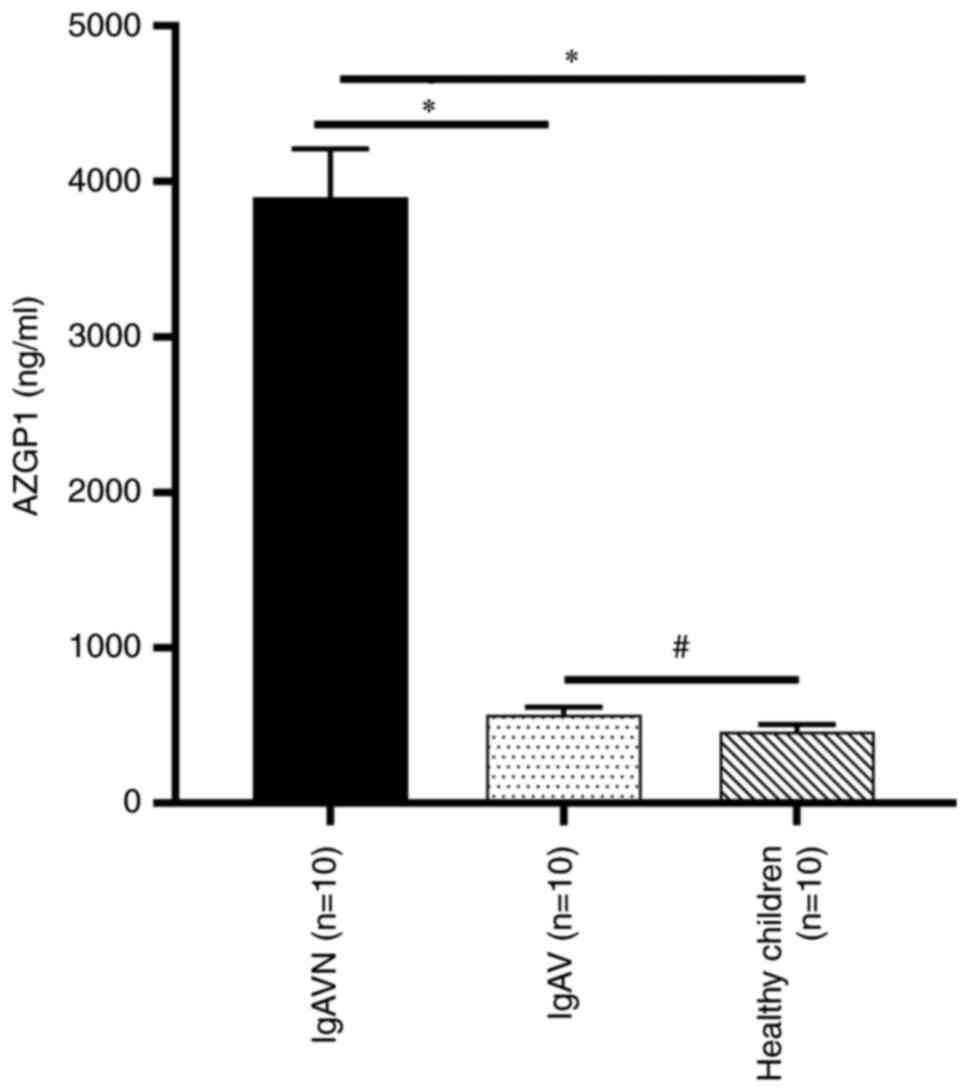AZGP1 as a potential biomarker of IgA vasculitis with nephritis in a children‑based urinary proteomics study by diaPASEF
- Authors:
- Published online on: June 30, 2023 https://doi.org/10.3892/mmr.2023.13044
- Article Number: 157
-
Copyright: © Zhu et al. This is an open access article distributed under the terms of Creative Commons Attribution License.
Abstract
Introduction
Immunoglobulin A vasculitis (IgAV), formerly known as Henoch-Schönlein purpura, is a systemic vasculitis caused by the deposition of immune complexes and is common in children. Its main feature is to cause skin purpura, joint pain, abdominal pain, hematuria and proteinuria (1). Worldwide, the incidence of IgAV in children is 10–20 per 100,000 per year, of which 90% of affected children are 2–10 years old, with a peak of 4–7 years old (2). Kidney involvement is an essential factor affecting long-term prognosis. IgAV with nephritis (IgAVN) accounts for 1–2% of children with end-stage kidney disease. Although the incidence of IgAVN varies with different research samples and diagnostic criteria, it can reach 20–54% (3,4). For most children with IgAV, abdominal pain or joint pain is only acute damage. Once the kidney is involved (when IgAV progresses to IgAVN), IgAVN will affect the long-term quality of life of children. Therefore, early identification of IgAVN and assessment of the level of risk of renal involvement are clinically critical.
Currently, there is a lack of specific biomarkers for renal damage in IgAV, so it is necessary to use proteomics to perform such research. There have been proteomic studies based on serum and renal tissues in children with IgAV (5,6). However, there are few experiments on proteomics using urine and there is a lack of large-sample experiments (7). The present study chose urine as the sample. Urine has some advantages and it is relatively easy to obtain samples. The urine test is non-invasive and renal function problems can be determined without pain or discomfort (8). In addition to routine renal biopsy, the biomarkers found in urine are the most reliable for renal disease assessment (9).
Liquid chromatography-tandem mass spectrometry (LC-MS/MS)-based proteomics technology provides a high-throughput method for protein quantification, which is significantly higher than that of western blotting and ELISA (10). Compared with data-dependent acquisition, data-independent acquisition (DIA) technology used in large samples is superior, but due to the complexity of proteomics samples and the limitations of collection speed and sensitivity of mass spectrometry, the unbiased measurement of proteomes remains difficult (11,12). It has been shown that the addition of the separation of ion mobility can further improve the sensitivity of protein identification and reduce spectral complexity based on retention time, m/z and intensity (11). Parallel accumulation-serial fragmentation (PASEF), which is a method for synchronizing mobility separation with quadrupole quality selection, is joined to DIA and termed diaPASEF (11,12). As a new generation of proteomics technology, diaPASEF can comprehensively improve the ability of protein identification, detection sensitivity and data integrity.
Therefore, the present study aimed to determine the difference in urinary protein content between children with IgAVN and normal children based on the technical platform of diaPASEF and bioinformatics analysis. Subsequently, the changes of identified protein content were verified by ELISA. It is suggested that the present study can provide valuable potential for the early identification and treatment of IgAVN.
Materials and methods
Specimens and clinical data
The present study involved children hospitalized in the First Affiliated Hospital of Anhui Medical University between 2020 and 2022. The diagnostic criteria of children with IgAVN were based on the criteria of The European League Against Rheumatism/Pediatric Rheumatology International Trials Organisation/Paediatric Rheumatology European Society (EULAR/PRINTO/PRES) (13): First, there is non-thrombocytopenic purpura that mainly occurs in the lower extremities and second, there is one of the following four criteria: i) Abdominal pain, ii) histologically positive IgA, iii) arthritis or joint pain and iv) renal damage (13). In addition, the criteria of IgAVN included in the present study met one of the following: i) Pathologically confirmed by renal biopsy and ii) 24-h urinary protein ≥150 mg/d. The healthy children in the experiment, according to the medical history, urine routine and renal function tests, were free of leukuria, proteinuria, hematuria and renal damage and children with kidney-related diseases were excluded.
The present study was divided into two parts. One was to analyze urinary proteomics between the IgAVN group and the healthy group and the other is to perform ELISA verification of specific proteins, including the IgAVN group, IgAV group and the healthy group. All the urine samples in the experiment were from mid-morning urine. The present study was approved by the Medical Ethics Review Committee of Anhui Medical University and written agreement was obtained from the guardians of all the children recruited.
Preparation, separation and digestion of proteins
Following centrifugation at 3,500 × g and 4°C for 10 min, the samples were stored at −80°C with low speed refrigerated centrifuge (cat. no. JW-1044R; Anhui Jiawen Instrument Equipment Co., Ltd.). After removing impurities, the samples were frozen at −80°C for storage. SDT buffer (4% SDS, 100 mM DTT and 150 mM Tris-HCl; pH 8.0) was incorporated into all samples. The detergent, DTT and other low-molecular-weight components were removed using UA buffer (8 M Urea and 150 mM Tris-HCl; pH 8.0) by repeated ultrafiltration (Microcon-10 kDa; MilliporeSigma). Then 100 µl iodoacetamide (100 mM IAM in UA buffer) was added to block reduced cysteine residues and the samples were incubated for 30 min in the dark. The filters were washed with 100 µl UA buffer three times and then 100 µl 25 mM NH4HCO3 buffer twice. Finally, the protein suspensions were digested with 4 µg trypsin (Promega Corporation) in 40 µl 25 mM NH4HCO3 buffer overnight at 37°C and the resulting peptides were collected as a filtrate. The peptides of each sample were desalted on C18 Cartridges [Empore SPE Cartridges C18 (standard density), bed I.D. 7 mm, volume 3 ml, MilliporeSigma], concentrated by vacuum centrifugation (cat. no. FD-80CE; Shanghai Bilon Instrument Co., Ltd.) at 25°C for 18 h and reconstituted in 40 µl of 0.1% (v/v) formic acid. The peptide content was estimated by UV light spectral density at 280 nm with NanoDrop 2000c (Thermo Fisher Scientific, Inc.). For DIA experiments, iRT (indexed retention time) calibration peptides were spiked into the sample.
A new generation of mass spectrometry-diaPASEF
The peptides from each sample were analyzed by nanpLC-MS/MS operating in the DIA mode. Nano-liter flow rate Evosep one system (Evosep Biosystems) was used for chromatographic separation. Buffer solutions: Solution A was 0.1% formic acid aqueous solution and solution B was 0.1% formic acid acetonitrile aqueous solution. The samples separated by nano-upgraded high-performance liquid chromatography were analyzed by trapped Ion Mobility Spectrometry (TIMS) time-of-flight mass spectrometer (Bruker Daltonics). The mass spectrometer collected ion mobility MS spectra over a mass range of m/z 100–1,700 and according to the m/z-ion mobility plane, up to eight windows for a single 100 ms TIMS scan were defined. During PASEF MS/MS scanning, the collision energy was ramped linearly as a function of the mobility from 20eV to 59 eV (14,15).
MS data analysis
The DIA data were processed by Spectronaut software (Spectronaut 14.4.200727.47784; Biognosys AG). The database was the UniProt_Human database (https://www.uniprot.org/; 2022_01 release), adding the indexed retention time (IRT) polypeptide sequence (Biognosys |iRTKit|). The search parameters were as follows: The enzyme was trypsin, the maximum number of miscleavage was 1, the fixed modification was carbamidomethyl and the dynamic modification is oxidation and acetyl (Protein N-term). The protein identified by database search had to pass the set filter parameter false discovery rate (FDR) <1%. Based on the spectrum library obtained by the above retrieval, the parameters of the Spectronaut software were set as follows: The retention time prediction type was dynamic IRT, interference on MS2 level correction is enabled and cross-run normalization is enabled. The results of all samples were filtered based on Q value cutoff of 0.01 (equivalent to FDR <1%).
Differential protein map and correlation analysis
To analyze the proteins with different expressions between the experimental groups, the preliminary experimental data were further screened for differences. In the screening of proteins with a significant difference, the following two screening conditions had to be met: The expression multiple (Fold Change, FC) between the two groups was >1.5 (upregulated by >1.5 or downregulated by <0.67 times) and two independent samples after Shapiro-Wilk test for normality were t-test (P<0.05). As a result, all the upregulated and downregulated proteins were obtained. Then hierarchical clustering analysis was carried out by using Cluster 3.0 (http://bonsai.hgc.jp/~mdehoon/software/cluster/software.htm) and Java TreeView software (http://jtreeview.sourceforge.net). Blast2Go (https://www.blast2go.com/) (16) software and the Kyoto Encyclopedia of Genes and Genomes (KEGG) pathway database (http://geneontology.org/) (17) were used to analyze the differential proteins. To find the more dominant differential proteins from the significant differential proteins, the protein-protein interaction network map was constructed by using Cytoscape software (http://www.cytoscape.org; version 3.2.1) based on the protein-protein interaction relationship in the STRING database (18).
ELISA identification of related specific proteins
Following thawing and centrifugation (3,500 × g and 4°C for 10 min), the three groups of urine samples used in the verification experiment were treated according to the instructions of the AZGP1 ELISA kit (cat. no. KA6083; Abnova). The optical density of the sample was measured by an optical densitometer and the quantitative analysis result of the verified protein was obtained.
Statistical analysis of data
In the baseline data, numerical variables are expressed as mean ± standard deviation, and the Student Newman Keuls test following one-way analysis of variance (ANOVA) was used for post-hoc analysis. In the bioinformatics analysis, unpaired t-test was used to screen differential proteins and Fisher's Exact Test was used to analyze the significance of differences. For AZGP1 protein, G*Power (3.1.9.7) (https://www.gpower.hhu.de/) was used to calculate the power of the results. Tukey's post-hoc multiple comparisons were performed following one-way ANOVA to compare differential levels of AZGP1, and the Spearman's correlation coefficient was used to evaluate its correlation with clinical data. SPSS (version 16.0; SPSS, Inc.) was used in data analysis. P<0.05 was considered to indicate a statistically significant difference.
Results
Clinical data of experimental specimens
The clinical data for all specimens used in the experiment are shown in Table I. First, eight specimens from the disease group (Group 1) and eight samples from the healthy group (Group 2) were selected for the proteomics experiment. Then, 30 samples of IgAVN, IgAV and healthy children were collected for verification experiments. According to the results of S-N-K test of analysis of variance, the P-values of age, body weight, eGFR and serum creatinine were all >0.05. No statistical difference was observed in these indexes between the experimental group and the verification group, suggesting that there was little interference from the baseline data difference in the follow-up experiment, which further ensured its accuracy.
Significant difference in protein
Using the diaPASEF technique, 254 differential proteins were screened from the experimental group according to the expression multiple (FC) and P<0.05. Among the differential proteins, 190 proteins were upregulated (FC >1.5) and 64 proteins were downregulated (FC <0.67; Fig. 1).
In the common clinical urine protein, consistent with the baseline data, some of the common urinary proteins were different, such as serotransferrin (TF; FC18.59; P=0.002) and albumin (ALB; FC9.256; P=0.002), while no significant differences were observed in some of them, such as retinol-binding protein (FC1.438; P=0.2453), α-1-microglobulin (FC1.310; P=0.4438) and β-2 microglobulin (FC1.587; P=0.2839). With cystatin-C (FC0.9379; P=0.7529), no differential expression was found in the experimental results. Part of the differential proteins (FC >3 or FC <0.34) were analyzed by hierarchical cluster analysis using Cluster 3.0 and Java Tree View software and were represented by tree heat map (Fig. 2). To better show the significant difference in proteins between the experimental groups, a volcano plot was drawn based on the expression difference multiple and P-value, and the 10 proteins with the most significant differences between upregulated and downregulated proteins were labeled (Fig. 3).
Functional notes and analysis of GO (Gene ontology)
To fully understand the function, location and biological pathway of proteins in organisms, proteins were annotated by GO. GO functional annotations are mainly divided into three categories: Biological Process (BP), Cellular Component (CC) and Molecular Function (MF). In the present study, GO functional annotation was performed on all differentially expressed proteins by using Blast2Go (https://www.blast2go.com/) software (Fig. 4).
All differentially expressed proteins and all identified proteins were compared with the annotation results of GO function and the functional categories of all differentially expressed proteins were found by Fisher's Exact Test (P<0.05). A histogram was used to show the enrichment of top20 under the three classifications of GO function (Fig. 5).
The results of GO enrichment analysis showed that, among the proteins involved in BP, ‘adaptive immune response’, ‘positive regulation of B cell activation’, ‘classical complement activation pathway’, ‘B cell receptor signaling pathway’, ‘phagocytosis, recognition’, ‘humoral immune response mediated by circulating immunoglobulin’, ‘regulation of B cell activation’, ‘B cell-mediated immunity’ and ‘immunoglobulin mediated immune response’ were significantly enriched. Among CC, the expression of ‘immunoglobulin complex’ and ‘circulating immunoglobulin complex’ was the most evident. In MF, significant enrichment was also associated with ‘antigen binding’ and ‘immunoglobulin receptor binding’.
KEGG pathway analysis
In order to further study the biological function of differential proteins, all differential proteins were subjected to KEGG pathway analysis. As shown in the Fig. 6, there were 20 major pathways, namely ‘Endocytosis’, ‘Cell adhesion molecules’, ‘Human papillomavirus infection’, ‘Lysosome’, ‘Phagosome’, ‘Shigellosis’, ‘Pathways in cancer’, ‘Cytokine-cytokine receptor interaction’, ‘Axon guidance’, ‘Complement and coagulation cascades’, ‘Regulation of actin cytoskeleton’, ‘Thyroid hormone synthesis’, ‘Pathways of neurodegeneration-multiple diseases’, ‘Human T-cell leukemia virus 1 infection’, ‘Epstein-Barr virus infection’, ‘MAPK signaling pathway’, ‘PI3K-Akt signaling pathway’, ‘Necroptosis’, ‘Vascular smooth muscle contraction’ and ‘Focal adhesion’. Among them, the leading ones were ‘Endocytosis’ and ‘Cell adhesion molecules’.
Network analysis of protein-protein interaction
The interaction network analysis of all differential proteins is shown in Fig. 7. According to the two conditions, the specific differential protein was selected as AZGP1. First, it can be seen from the volcano map that AZGP1 ranks second in the top 20; in differential expression AZGP1 participates in the highest degree of connectivity in the interaction network and has an interaction with 13 differential proteins. The interacting proteins are transmembrane emp24 domain-containing protein 9, ALB, TF, α-2-macroglobulin, leucine-rich α-2-glycoprotein, cysteine-rich secretory protein 3, α-1-antitrypsin, adiponectin, apolipoprotein D, haptoglobin, ceruloplasmin, α-1-acid glycoprotein 1 and famin. Combined with the GO function results, it was shown that AZGP1 and interacting proteins are related to extracellular space, extracellular region part, extracellular region, establishment of localization, transport and localization.
ELISA verification of specific differential proteins
Through the previous analysis, a more specific differential protein, AZGP1, was found. Considering that the sample size was small, a post-hoc analysis of the AZGP1 data by G*Power (3.1.9.7) was performed and it was found that the power (1-β) was 0.53, where β indicates a class II error when <0.5. To verify the reliability of this protein, further ELISA experiments were performed. The ELISA results showed that urinary AZGP1 levels in IgAVN were significantly higher compared with those in IgAV and healthy children and that there was no significant difference between IgAV and healthy children (Fig. 8). The association of urinary levels of AZGP1 with serum creatinine and eGFR was evaluated and it was found that urinary AZGP1 levels were no correlation with serum creatinine (P=0.086) and eGFR (P=0.055).
Discussion
Generally speaking, IgAV is a common disease in childhood and, when the kidney is involved, it will affect the long-term prognosis of children as with all kinds of nephropathy. Despite the lack of authoritative evidence-based medicine for the treatment of IgAVN, the earlier the occurrence of IgAV nephritis is identified, is still valuable (19). In recent years, there have been a number of reports on urinary proteomics in other kidney diseases, including IgAN, lupus nephritis (LN) and nephrotic syndrome (20–31). The study of IgAVN is more limited to the study and verification of known markers of renal damage and less valuable markers for future research are suggested through proteomics, especially with urine as samples (6,7,32). The purpose of the present study was to explore the specific markers in urine, which is of value to the future investigation of pathological mechanism and more accurate treatment of IgAVN. In addition, through a new generation of proteomics technology, the number of proteins identified was significantly greater than in the past, which provided more basic data for further research.
In present study, there was a specific upregulated protein, AZGP1. According to the results of expression multiple (FC) and P-value, it can be stated that the expression difference of AZGP1 is the most significant. According to PPI, AZGP1 has more correlation with other proteins, which is valuable for further research. Therefore, the present study chose AZGP1 as the object of further study. It was further verified that there was differential expression between IgAVN and non-IgAVN children.
AZGP1 is a secretory glycoprotein of ~40 kDa and was first isolated from human plasma 60 years ago. It is mainly expressed in adipocytes and epithelial cells, including renal tubular epithelial cells (33). Earlier studies have shown that blood AZGP1 is significantly increased in patients with chronic hemodialysis and early acute kidney injury (34). For the study of urine AZGP1 10 years ago, it was proposed that urine AZGP1 may be used as a biomarker of diabetic nephropathy (35). Then, in a biomarker experiment of active LN, it was found that there was no obvious specificity of urinary AZGP1 (36). Initially, an experimental study suggested that when the proximal tubule was damaged, the reabsorption was insufficient, which led to an increase in the amount of protein excreted from the urine and, due to increased filtration of other proteins, especially albumin, the reabsorption capacity of the renal tubule was saturated, increasing urinary AZGP1 excretion (37). Moreover, it is generally hypothesized that the passive accumulation of blood AZGP1 is caused by a decrease in renal clearance ability. Notably, when studying the factors related to metabolic disorders related to chronic kidney disease (CKD), some studies have suggested that AZGP1 may increase lipolysis and reduce fat production through overproduction (38). At present, it is unclear whether the increase of AZGP1 in urine comes from kidney damage or the increase in production is caused by the disease itself. In particular, a strong correlation between plasma AZGP1 and GFR has not been found, only confirmation that there is a significant increase in blood AZGP1 only in CKD 5 phase (39). Therefore, although the metabolic mechanism of AZGP1 in kidney disease remains to be elucidated, urine AZPG1 may show abnormalities earlier in disease progression than blood AZGP1. The reliability of its relative value needs to be confirmed by further research.
The HLA-B35 gene is not only associated with the pathogenesis of IgAN but increases the risk of IgAVN (40). Significantly, HLA-B35 is attributed to MHC-I molecules, while AZGP1 molecules are highly similar to MHC-I molecules in structure, which may play a role in the pathogenesis of IgAVN by binding to T cells and presenting lipid ligands (41). Initially, AZGP1 was isolated as a factor that can lead to weight loss by inhibiting animal feeding, indicating that there is a direct relationship between immune function and nutritional metabolism, but the pathway of action is not clear (42). AZGP1 plays an important role as a fat factor in the immune process of atopic dermatitis, rheumatoid arthritis, AIDS, cachexia and other diseases (43–46). To study AZGP1 in kidney disease, Schmitt et al (47), through the study of AZGP1 deficient mice, concluded that AZGP1 deficient mice showed higher susceptibility to renal fibrosis, so it was found that AZGP1 seemed to play a stable role in cell integrity and epithelial differentiation (48). However, Schmitt et al (47) found that aging and loss of proliferation of renal epithelial cells were associated with increased expression of AZGP1 and inhibition of AZGP1 in the aging kidney could increase the proliferative response after injury (47). Therefore, under normal expression, AZGP1 should have a protective effect on the kidney, but when the kidney is damaged, AZGP1 will be overexpressed, aggravating the kidney damage. Under renal injury, renal injury and fibrosis can be alleviated by significantly increasing IL-33R+ and IL-2Ra+ regulatory T cells in renal tissue (49). Although no direct interaction between AZGP1 and T cells was found, an amino acid sequence (Arg-Gly-Asp-Val) that could interact with cell surface integrin was found in AZGP1 (50,51). AZGP1 may cause renal involvement through the aforementioned processes in the progression of IgAV disease.
In addition, according to GO enrichment and KEGG pathway analysis, most of the differential proteins are closely related to the immune response in biological processes, cell composition and molecular function and participate in endocytosis and cell adhesion. In patients with IgAV, immune complexes formed during immune response not only activate mesangial cells and induce mesangial proliferation, but also induce the expression of pro-inflammatory cytokines and chemokines (IL-6, IL-8, TNF and MCP-1) and induce apoptosis of podocytes and renal tubular epithelial cells. The above effects lead to the recruitment of inflammatory cells and further damage to the kidney (52). In a study of IgAVN mechanism, complement activation is involved in the damage of glomerular structure (53). The present study found that complement C4-B and complement C1R were differentially expressed (data not shown).
In summary, 254 differential proteins were screened by a new generation of proteomic technology. The present study has some limitations, for example, the sample size was relatively small and larger samples are needed to verify it so that the protein differences between different renal pathological types can be further explored. In addition, the present study failed to further study the mechanism of AZGP1. However, the differential proteins in the results of the present study can still provide value for future research. The present study validated AZGP1 as possessing potential value as a new biomarker. In the future, the role of AZGP1 in the pathogenesis of IgAVN and the application of urinary AZGP1 to guide clinical diagnosis and treatment will be clarified.
Acknowledgements
Not applicable.
Funding
The present study was funded by the Natural Science Research Project of Higher Education of Anhui Province of China (grant no. KJ2019A0245) and the Foundation of Anhui Medical University (grant no. 2020×kj174). There were no funders involved in the study design, data analysis, manuscript preparation, or publication of the study findings.
Availability of data and materials
The mass spectrometry proteomics data have been deposited to the ProteomeXchange Consortium (http://proteomecentral.proteomexchange.org) via the iProX partner repository with the dataset identifier PXD042355. The additional datasets used and/or analyzed during the current study are available from the corresponding author on reasonable request.
Authors' contributions
ZQZ, TZ, SC, ZHR, QZ contributed to the study conception and design. ZQZ, TZ, SC wrote the manuscript and collected and analyzed data. ZHR and QZ critically revised the final manuscript. ZQZ and QZ confirm the authenticity of all the raw data. All authors read and approved the final manuscript.
Ethics approval and consent to participate
The research protocol was approved by the Biomedical Ethics Committee of Anhui Medical University (Hefei, China; approval no. 20190812). Written informed consent was obtained from the guardians of all children prior to the enrollment of this study.
Patient consent for publication
Not applicable.
Competing interests
The authors declare that they have no competing interests.
Glossary
Abbreviations
Abbreviations:
|
AZGP1 |
zinc-alpha-2-glycoprotein |
|
CKD |
chronic kidney disease |
|
DIA |
data-independent acquisition |
|
PASEF |
parallel accumulation-serial fragmentation |
|
diaPASEF |
parallel accumulation-serial fragmentation combined with data-independent acquisition |
|
GO |
Gene Ontology |
|
IgAV |
Immunoglobulin A vasculitis |
|
IgAVN |
IgAV with nephritis |
|
KEGG |
Kyoto Encyclopedia of Gene and Genome |
|
LC-MS/MS |
liquid chromatography-tandem mass spectrometry |
References
|
Chen J, Fang X, Dang X, Wu X and Yi Z: Association of the paired box 2 gene polymorphism with the susceptibility and pathogenesis of Henoch-Schönlein Purpura in children. Mol Med Rep. 11:1997–2003. 2015. View Article : Google Scholar : PubMed/NCBI | |
|
Leung AKC, Barankin B and Leong KF: Henoch-Schönlein Purpura in Children: An updated review. Curr Pediatric Rev. 16:265–276. 2020. View Article : Google Scholar : PubMed/NCBI | |
|
Pillebout E and Sunderkotter C: IgA vasculitis. Semin Immunopathol. 43:729–738. 2021. View Article : Google Scholar : PubMed/NCBI | |
|
Oni L and Sampath S: Childhood IgA vasculitis (Henoch Schonlein Purpura)-advances and knowledge gaps. Front Pediatr. 7:2572019. View Article : Google Scholar : PubMed/NCBI | |
|
Xie B, Zhang W, Zhang Q, Zhang Q, Wang Y, Sun L, Liu M and Zhou P: An integrated transcriptomic and proteomic analysis identifies significant novel pathways for Henoch-Schönlein Purpura nephritis progression. Biomed Res Int. 2020:24891752020. View Article : Google Scholar : PubMed/NCBI | |
|
Gao R, Niu X, Zhu L, Qi R and He L: iTRAQ quantitative proteomic analysis differentially expressed proteins and signal pathways in Henoch-Schönlein Purpura nephritis. Am J Transl Res. 12:7908–7922. 2020.PubMed/NCBI | |
|
Fang X, Wu H, Lu M, Cao Y, Wang R, Wang M, Gao C and Xia Z: Urinary proteomics of Henoch-Schönlein Purpura nephritis in children using liquid chromatography-tandem mass spectrometry. Clin Proteomics. 17:102020. View Article : Google Scholar : PubMed/NCBI | |
|
Naderi AS and Reilly RF: Primary care approach to proteinuria. J Am Board Fam Med. 21:569–574. 2008. View Article : Google Scholar : PubMed/NCBI | |
|
Taherkhani A, Farrokhi Yekta R, Mohseni M, Saidijam M and Arefi Oskouie A: Chronic kidney disease: A review of proteomic and metabolomic approaches to membranous glomerulonephritis, focal segmental glomerulosclerosis, and IgA nephropathy biomarkers. Proteome Sci. 17:72019. View Article : Google Scholar : PubMed/NCBI | |
|
Li J, Smith LS and Zhu HJ: Data-independent acquisition (DIA): An emerging proteomics technology for analysis of drug-metabolizing enzymes and transporters. Drug discovery today. Technologies. 39:49–56. 2021.PubMed/NCBI | |
|
Demichev V, Szyrwiel L, Yu F, Teo GC, Rosenberger G, Niewienda A, Ludwig D, Decker J, Kaspar-Schoenefeld S, Lilley KS, et al: dia-PASEF data analysis using FragPipe and DIA-NN for deep proteomics of low sample amounts. Nat Commun. 13:39442022. View Article : Google Scholar : PubMed/NCBI | |
|
Mun DG, Vanderboom PM, Madugundu AK, Garapati K, Chavan S, Peterson JA, Saraswat M and Pandey A: DIA-based proteome profiling of nasopharyngeal Swabs from COVID-19 patients. J Proteome Res. 20:4165–4175. 2021. View Article : Google Scholar : PubMed/NCBI | |
|
Ozen S, Pistorio A, Iusan SM, Bakkaloglu A, Herlin T, Brik R, Buoncompagni A, Lazar C, Bilge I, Uziel Y, et al: EULAR/PRINTO/PRES criteria for Henoch-Schönlein Purpura, childhood polyarteritis nodosa, childhood Wegener granulomatosis and childhood Takayasu arteritis: Ankara 2008. Part II: Final classification criteria. Ann Rheum Dis. 69:798–806. 2010. View Article : Google Scholar : PubMed/NCBI | |
|
Parker SJ, Rost H, Rosenberger G, Collins BC, Malmström L, Amodei D, Venkatraman V, Raedschelders K, Van Eyk JE and Aebersold R: Identification of a set of conserved eukaryotic internal retention time standards for data-independent acquisition mass spectrometry. Mol Cell Proteomics. 14:2800–2813. 2015. View Article : Google Scholar : PubMed/NCBI | |
|
Meier F, Brunner AD, Koch S, Koch H, Lubeck M, Krause M, Goedecke N, Decker J, Kosinski T, Park MA, et al: Online parallel accumulation-serial fragmentation (PASEF) with a novel trapped ion mobility mass spectrometer. Mol Cell Proteomics. 17:2534–2545. 2018. View Article : Google Scholar : PubMed/NCBI | |
|
Gotz S, Garcia-Gomez JM, Terol J, Williams TD, Nagaraj SH, Nueda MJ, Robles M, Talón M, Dopazo J and Conesa A: High-throughput functional annotation and data mining with the Blast2GO suite. Nucleic Acids Res. 36:3420–3435. 2008. View Article : Google Scholar : PubMed/NCBI | |
|
Kanehisa M, Goto S, Sato Y, Furumichi M and Tanabe M: KEGG for integration and interpretation of large-scale molecular data sets. Nucleic Acids Res. 40:D109–D114. 2012. View Article : Google Scholar : PubMed/NCBI | |
|
Szklarczyk D, Franceschini A, Wyder S, Forslund K, Heller D, Huerta-Cepas J, Simonovic M, Roth A, Santos A, Tsafou KP, et al: STRING v10: Protein-protein interaction networks, integrated over the tree of life. Nucleic Acids Res. 43:D447–D452. 2015. View Article : Google Scholar : PubMed/NCBI | |
|
Chen JY and Mao JH: Henoch-Schönlein Purpura nephritis in children: Incidence, pathogenesis and management. World J Pediatr. 11:29–34. 2015. View Article : Google Scholar : PubMed/NCBI | |
|
Mucha K, Bakun M, Jazwiec R, Dadlez M, Florczak M, Bajor M, Gala K and Pączek L: Complement components, proteolysisrelated, and cell communicationrelated proteins detected in urine proteomics are associated with IgA nephropathy. Pol Arch Med Wewn. 124:380–386. 2014.PubMed/NCBI | |
|
Surin B, Sachon E, Rougier JP, Steverlynck C, Garreau C, Lelongt B, Ronco P and Piedagnel R: LG3 fragment of endorepellin is a possible biomarker of severity in IgA nephropathy. Proteomics. 13:142–152. 2013. View Article : Google Scholar : PubMed/NCBI | |
|
Neprasova M, Maixnerova D, Novak J, Reily C, Julian BA, Boron J, Novotny P, Suchanek M, Tesar V and Kacer P: Toward noninvasive diagnosis of IgA nephropathy: A Pilot urinary metabolomic and proteomic study. Dis Markers. 2016:36509092016. View Article : Google Scholar : PubMed/NCBI | |
|
Guo Z, Wang Z, Lu C, Yang S, Sun H, Reziw, Guo Y, Sun W and Yue H: Analysis of the differential urinary protein profile in IgA nephropathy patients of Uygur ethnicity. BMC Nephrol. 19:3582018. View Article : Google Scholar : PubMed/NCBI | |
|
Rocchetti MT, Papale M, d'Apollo AM, Suriano IV, Di Palma AM, Vocino G, Montemurno E, Varraso L, Grandaliano G, Di Paolo S and Gesualdo L: Association of urinary laminin G-like 3 and free K light chains with disease activity and histological injury in IgA nephropathy. Clin J Am Soc Nephrol. 8:1115–1125. 2013. View Article : Google Scholar : PubMed/NCBI | |
|
He Q, Shao L, Yu J, Ji S, Wang H, Mao Y and Chen J: Urinary proteome analysis by matrix-assisted laser desorption/ionization time-of-flight mass spectrometry with magnetic beads for identifying the pathologic presentation of clinical early IgA nephropathy. J Biomed Nanotechnol. 8:133–139. 2012. View Article : Google Scholar : PubMed/NCBI | |
|
Taylor S, Pieri K, Nanni P, Tica J, Barratt J and Didangelos A: Phosphatidylethanolamine binding protein-4 (PEBP4) is increased in IgA nephropathy and is associated with IgA-positive B-cells in affected kidneys. J Autoimmun. 105:1023092019. View Article : Google Scholar : PubMed/NCBI | |
|
Rudnicki M, Siwy J, Wendt R, Lipphardt M, Koziolek MJ, Maixnerova D, Peters B, Kerschbaum J, Leierer J, Neprasova M, et al: Urine proteomics for prediction of disease progression in patients with IgA nephropathy. Nephrol Dial Transplant. 37:42–52. 2021. View Article : Google Scholar : PubMed/NCBI | |
|
Ning X, Yin Z, Li Z, Xu J, Wang L, Shen W, Lu Y, Cai G, Zhang X and Chen X: Comparative proteomic analysis of urine and laser microdissected glomeruli in IgA nephropathy. Clin Exp Pharmacol Physiol. 44:576–585. 2017. View Article : Google Scholar : PubMed/NCBI | |
|
Turnier JL, Brunner HI, Bennett M, Aleed A, Gulati G, Haffey WD, Thornton S, Wagner M, Devarajan P, Witte D, et al: Discovery of SERPINA3 as a candidate urinary biomarker of lupus nephritis activity. Rheumatology (Oxford). 58:321–330. 2019. View Article : Google Scholar : PubMed/NCBI | |
|
Cai Z, Zhang S, Wu P, Ren Q, Wei P, Hong M, Feng Y, Wong CK, Tang H and Zeng H: A novel potential target of IL-35-regulated JAK/STAT signaling pathway in lupus nephritis. Clin Transl Med. 11:e3092021. View Article : Google Scholar : PubMed/NCBI | |
|
Varghese SA, Powell TB, Budisavljevic MN, Oates JC, Raymond JR, Almeida JS and Arthur JM: Urine biomarkers predict the cause of glomerular disease. J Am Soc Nephrol. 18:913–922. 2007. View Article : Google Scholar : PubMed/NCBI | |
|
He X, Yin W, Ding Y, Cui SJ, Luan J, Zhao P, Yue X, Yu C, Laing X and Zhao Y: Higher serum angiotensinogen is an indicator of IgA vasculitis with nephritis revealed by comparative proteomes analysis. PLoS One. 10:e01305362015. View Article : Google Scholar : PubMed/NCBI | |
|
Schmitt R: ZAG-a novel biomarker for cardiovascular risk in ESRD patients? Kidney Int. 94:858–860. 2018. View Article : Google Scholar : PubMed/NCBI | |
|
Sörensen-Zender I, Beneke J, Schmidt BM, Menne J, Haller H and Schmitt R: Zinc-alpha2-glycoprotein in patients with acute and chronic kidney disease. BMC Nephrol. 14:1452013. View Article : Google Scholar : PubMed/NCBI | |
|
Soggiu A, Piras C, Bonizzi L, Hussein HA, Pisanu S and Roncada P: A discovery-phase urine proteomics investigation in type 1 diabetes. Acta Diabetol. 49:453–464. 2012. View Article : Google Scholar : PubMed/NCBI | |
|
Somparn P, Hirankarn N, Leelahavanichkul A, Khovidhunkit W, Thongboonkerd V and Avihingsanon Y: Urinary proteomics revealed prostaglandin H(2)D-isomerase, not Zn-alpha2-glycoprotein, as a biomarker for active lupus nephritis. J Proteomics. 75:3240–3247. 2012. View Article : Google Scholar : PubMed/NCBI | |
|
Ekman R, Johansson BG and Ravnskov U: Renal handling of Zn-alpha2-glycoprotein as compared with that of albumin and the retinol-binding protein. J Clin Invest. 57:945–954. 1976. View Article : Google Scholar : PubMed/NCBI | |
|
Pelletier CC, Koppe L, Croze ML, Kalbacher E, Vella RE, Guebre-Egziabher F, Géloën A, Badet L, Fouque D and Soulage CO: White adipose tissue overproduces the lipid-mobilizing factor zinc alpha2-glycoprotein in chronic kidney disease. Kidney Int. 83:878–886. 2013. View Article : Google Scholar : PubMed/NCBI | |
|
Pelletier CC, Koppe L, Alix PM, Kalbacher E, Croze ML, Hadj-Aissa A, Fouque D, Guebre-Egziabher F and Soulage CO: The relationship between renal function and plasma concentration of the cachectic factor zinc-alpha2-glycoprotein (ZAG) in adult patients with chronic kidney disease. PLoS One. 9:e1034752014. View Article : Google Scholar : PubMed/NCBI | |
|
Robson KJ, Ooi JD, Holdsworth SR, Rossjohn J and Kitching AR: HLA and kidney disease: From associations to mechanisms. Nat Rev Nephrol. 14:636–655. 2018. View Article : Google Scholar : PubMed/NCBI | |
|
Bouchara A, Yi D, Pastural M, Granjon S, Selag JC, Laville M, Arkouche W, Pelletier S, Fouque D, Soulage CO and Koppe L: Serum levels of the adipokine zinc-alpha2-glycoprotein (ZAG) predict mortality in hemodialysis patients. Kidney Int. 94:983–992. 2018. View Article : Google Scholar : PubMed/NCBI | |
|
Matarese G and La Cava A: The intricate interface between immune system and metabolism. Trends Immunol. 25:193–200. 2004. View Article : Google Scholar : PubMed/NCBI | |
|
Noh JY, Shin JU, Kim JH, Kim SH, Kim BM, Kim YH, Park S, Kim TG, Shin KO, Park K and Lee KH: ZAG regulates the skin barrier and immunity in atopic dermatitis. J Invest Dermatol. 139:1648–1657. e16472019. View Article : Google Scholar : PubMed/NCBI | |
|
Na HS, Kwon JE, Lee SH, Jhun J, Kim SM, Kim SY, Kim EK, Jung K, Park SH and Cho ML: Th17 and IL-17 cause acceleration of inflammation and fat loss by inducing alpha2-glycoprotein 1 (AZGP1) in rheumatoid arthritis with high-fat diet. Am J Pathol. 187:1049–1058. 2017. View Article : Google Scholar : PubMed/NCBI | |
|
Yeregui E, Masip J, Viladés C, Domingo P, Pacheco YM, Blanco J, Mallolas J, Alba V, Vargas M, García-Pardo G, et al: Adipokines as new biomarkers of immune recovery: Apelin receptor, RBP4 and ZAG are related to CD4(+) T-cell reconstitution in PLHIV on suppressive antiretroviral therapy. Int J Mol Sci. 23:22022022. View Article : Google Scholar : PubMed/NCBI | |
|
Romauch M: Zinc-alpha2-glycoprotein as an inhibitor of amine oxidase copper-containing 3. Open Biol. 10:1900352020. View Article : Google Scholar : PubMed/NCBI | |
|
Schmitt R, Marlier A and Cantley LG: Zag expression during aging suppresses proliferation after kidney injury. J Am Soc Nephrol. 19:2375–2383. 2008. View Article : Google Scholar : PubMed/NCBI | |
|
Sörensen-Zender I, Bhayana S, Susnik N, Rolli V, Batkai S, Baisantry A, Bahram S, Sen P, Teng B, Lindner R, et al: Zinc-alpha2-Glycoprotein exerts antifibrotic effects in kidney and heart. J Am Soc Nephrol. 26:2659–2668. 2015. View Article : Google Scholar : PubMed/NCBI | |
|
do Valle Duraes F, Lafont A, Beibel M, Martin K, Darribat K, Cuttat R, Waldt A, Naumann U, Wieczorek G, Gaulis S, et al: Immune cell landscaping reveals a protective role for regulatory T cells during kidney injury and fibrosis. JCI Insight. 5:e1306512020. View Article : Google Scholar : PubMed/NCBI | |
|
Adams EJ and Luoma AM: The adaptable major histocompatibility complex (MHC) fold: Structure and function of nonclassical and MHC class I-like molecules. Annu Rev Immunol. 31:529–561. 2013. View Article : Google Scholar : PubMed/NCBI | |
|
Takagaki M, Honke K, Tsukamoto T, Higashiyama S, Taniguchi N, Makita A and Ohkubo I: Zn-alpha 2-glycoprotein is a novel adhesive protein. Biochem Biophys Res Commun. 201:1339–1347. 1994. View Article : Google Scholar : PubMed/NCBI | |
|
Song Y, Huang X, Yu G, Qiao J, Cheng J, Wu J and Chen J: Pathogenesis of IgA Vasculitis: An Up-to-date review. Front Immunol. 12:7716192021. View Article : Google Scholar : PubMed/NCBI | |
|
Chimenti MS, Ballanti E, Triggianese P and Perricone R: Vasculitides and the complement system: A comprehensive review. Clin Rev Allergy Immunol. 49:333–346. 2015. View Article : Google Scholar : PubMed/NCBI |



